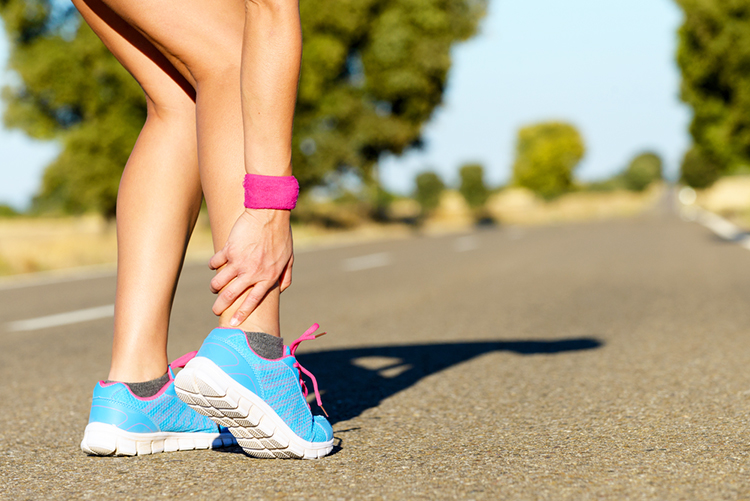4 Tips for Preventing Tight Ankles and the Chain Reaction Of Pain It Can Create
Posted by Goggles N More on 28th Jan 2016
Shop Prescription Sports Sunglasses

It’s the easiest thing in the world to turn an ankle. And one of the most common sports injuries of all. Which is probably why we are all guilty of under-playing the consequences. After the initial searing pain, we limp home, reach for the pain-killers, chuck the frozen peas on the swollen ankle, put the foot up for an hour or two, and hobble around for a couple of days. Then we tend to resume business as usual.
If we’re lucky, we get away with it. But, as you will soon find out, ankles are complicated structures and ankle injuries tend to be trickier than we assume. Even the simple sprains can leave strange after affects that will follow you around like a bad smell. Side affects like reduced balance, repeat incidents, new pain in other places sometimes years after.
And too often, what we assume to be simple sprains turn into more complicated injuries that need highly specialized care. But as we will discuss here it is often the simple things you need to do that make the biggest difference.
The funny thing about tight ankles is you don’t have to have had an ankle injury to get it. In many cases it is a postural problem and in every case it will come back to weak glutes and a weak core!
This creates what is known as flat feet, resulting in reduced movement in ‘dorsiflexion’ (flexing the foot by pulling the toes up towards the leg). If this is not rehabilitated properly, it can place greater biomechanical demands on the body during everyday movements such as squats. This is a very common thing we see in the gym and the person who does squats like this will end up with knee pain - guaranteed! So although the knee is in pain, it was the ankle's fault! Meaning until you fix the limitation of the ankle you will continue to have knee pain!
The most common postural fault we see is a lordosis type posture that has an anterior tilted pelvis. This will cause the legs to rotate in otherwise known as pronation causing flat feet and a high risk of the knee being forced into a position that will create a shearing effect that ultimately leads to pain!
Also ankle restriction will greatly reduce the ability to squat, walk or run correctly and without you realizing it, every movement you make now is in a compensatory action! Tight calves and poor ankle mobility is one of the biggest reasons people lack range of movement with their squat. This increases the chance of performing a squat that exposes the knees to take the load. You only a few hundred of these and you will be in pain!
High Heel Shoes For Women
And one of the quickest ways to create tight ankles and calf muscles is to start wearing high heel shoes! Wearing high heels will shorten and tighten the calf muscles, which often pulls the knees into hyperextension, and creates a greater anterior tilt of the pelvis. It is like one massive chain reaction as the greater anterior tilt now creates weaker abdominals due to them being stretched, tighter hips, a greater curve at the neck due to the spine being buckled down at the pelvis.
Dorsiflexion is something we all tend to take for granted in daily life and in sport. Lunging, ascending and descending stairs, squatting and getting into and out of a car all require it.
In sports that need explosive movements in various multidirectional patterns like tennis &, basketball, the sportsperson must dorsiflex effectively into many angles, so as to transfer load and change direction. A tight ankle not only restricts this but forces the body to compensate and find a new way to do what you want to do. It is this compensation that creates new injuries and pain! If a solution is not found a lifetime of chronic pain will set in.
What Should You Do To Prevent & Correct This Problem?
Test Flexibility
The ankle dorsiflexion lunge Weight-bearing mostly through the (front) test leg, the person moves their foot back as far as possible, while still being able to dorsiflex with the heel on the ground so the knee touches the wall in front. The foot should point directly ahead and the knee should move directly over this. The distance from the end of the big toe to wall is measured. You should be able to achieve 8cm for normal flexibility.
Test Single Leg Squat
The single leg squat is an excellent test to use as it can pinpoint problems that may have started at the hip and created the ankle problem. It is also the movement that you are going to need when you walk so it makes sense to see if it is being performed correctly.
Improve Your Breathing
Yes you read that right and might be thinking what has that got to do with tight ankles. It has everything to do with it. Often something missed by most doctors and health practitioners. But understand that a person with forward head posture due to breathing dysfunction tends to lean forward on an angle in order to get more air. This places enormous stress on the entire achilles tendon and calf complex to prevent you falling on your face! No calf stretching or massage will ever changes this until you learn to breathe correctly and change your forward head posture.
Strengthen Your Glutes
We have sort of touched on this already but this really is the secret. You can stretch as much as you want. Rolling over a golf ball like everyone loves to use are great for relieving plantar fascia tightness but make no mistake it WILL NOT solve the problem. You must start using exercises that will strengthen your glutes to hold your leg in correct alignment and prevent you from rolling in. Best exercises are bridges, clams, single leg deadflits & traditional deadlifts.
Conclusion
There is a lot more to this topic than I have covered here in this article but this gives you a great idea as to where to start looking to resolve your problem. Always remember where the pain is, rarely is where the problem is. If you can improve the things I have listed above you will find that you will get on top of your problem effectively forever.
Prescription Swim Goggles – Sports Goggles – Ski Goggles
Leader in Prescription Goggles and Glasses
Kids RX Swim Goggles – Adult RX Swim Goggles – Prescription Sports Goggles - RX Ski Goggles





